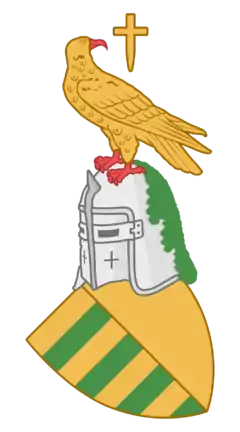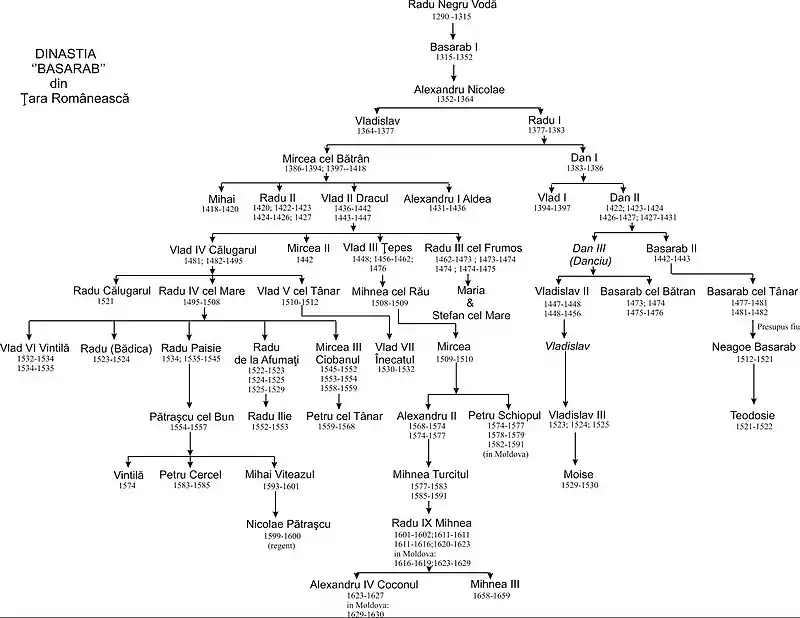House of Basarab
The House of Basarab (also Bazarab or Bazaraad, Romanian: Basarab pronounced [basaˈrab] ⓘ) was a ruling family of Cuman origin,[1] which had an important role in the establishing of the Principality of Wallachia, giving the country its first line of Princes, one closely related with the Mușatin rulers of Moldavia. Its status as a dynasty is rendered problematic by the official elective system, which implied that male members of the same family, including illegitimate offspring, were chosen to rule by a council of boyars (more often than not, the election was conditioned by the military force exercised by candidates). After the rule of Alexandru I Aldea (ended in 1436), the house was split by the conflict between the Dănești and the Drăculești, both of which claimed legitimacy. Several late rulers of the Craiovești claimed direct descent from the House after its eventual demise, including Neagoe Basarab, Matei Basarab, Constantin Șerban, Șerban Cantacuzino, and Constantin Brâncoveanu.
| House of Basarab | |
|---|---|
 | |
| Country | Wallachia |
| Founded | 1310 |
| Founder | Basarab I of Wallachia |
| Final ruler |
|
| Titles | Prince (Voivode; Hospodar) |
| Estate(s) | of Wallachia |
| Cadet branches | House of Dănești House of Drăculești |
Rulers usually mentioned as members of the House include (in chronological order of first rule) Mircea the Elder, Dan II, Vlad II Dracul, Vlad III the Impaler, Vlad the Monk, Radu IV the Great, and Radu of Afumați.
Name and origins
The dynasty was named after Basarab I, who gained the independence of Wallachia from the Kingdom of Hungary.
The name is likely of Cuman or Pecheneg Turkic[2][3][4][5] origin and most likely meant "father ruler". Basar was the present participle of the verb "to rule", derivatives attested in both old and modern Kypchak languages. The Romanian historian Nicolae Iorga believed the second part of the name, -aba ("father"), to be an honorary title, as recognizable in many Cuman names, such as Terteroba, Arslanapa, and Ursoba.
Basarab's "possible" father Thocomerius also bore an allegedly Cuman name, identified as Toq-tämir, a rather common Cuman and Tatar name in the 13th century. The Russian chronicles around 1295 refer to a Toktomer, a prince of the Mongol Empire present in Crimea.[6]
The Cuman or Pecheneg origin of the name indicates that the situation must have been very similar to what has been described in connection with the Asen family a hundred years before, although their origin is likewise disputed. Like Asen and his family, who were of non-Bulgarian extraction, and who founded a dynasty and became Bulgarians, Basarab and his family were also presumably of Cuman extraction, founded a dynasty, and became Romanians.[7]
Genealogy
The following genealogical tree is a simplified version, meant to show the ruling princes, their documented brothers and sisters, and the spouses/extramarital liaisons of those who had ruling heirs, following the conventions:
- Ruling princes have their name emphasized and their ruling years in Wallachia.
- Several members of House of Basarab ruled in Moldavia; those reigning years are marked with M.
- Small numbers at the end of each name are meant to indicate the mother of each offspring.
- There are two branches of the dynasty: Drăculeşti (DR) and Dăneşti (DA)
- If the prince died while ruling, the last year is preceded by a cross.
- Spouses and extramarital liaisons are separated by a horizontal line.
| Basarab I 1310-†1352 | Margareta | ||||||||||||||||||||||||||||||||||||||||||||||||||||||||||||||||||||||||||||||||||||||||||||||||||||||
| Theodora of Wallachia | Ivan Alexander of Bulgaria | Nicolae Alexandru 1352-†1364 | Maria Lackfy1 Clara Dobokai2 Maria Dabkai3 | ||||||||||||||||||||||||||||||||||||||||||||||||||||||||||||||||||||||||||||||||||||||||||||||||||||
| Royal dynasty of Bulgaria | Vladislav I1 1364-†1377 | Radu I1 1377-†1383 | Ana1 Kalinikia2 | Vladislaus II of Opole With Catarine Elis1 | {{{ELI}}} | Vojislav1 | Anna of Wallachia 2 | Ivan Sratsimir of Bulgaria | Anca2 | Stephen Uroš V of Serbia | |||||||||||||||||||||||||||||||||||||||||||||||||||||||||||||||||||||||||||||||||||||||||||||
| Dan IDA,1 1383-†1386 | Maria of Serbia | Mircea I2 1386-1394 1397-†1418 | Maria Tolmay 1 Anca2 | Staico2 | Royal dynasty of Silesia | Royal dynasty of Bulgaria | Royal dynasty of Serbia | ||||||||||||||||||||||||||||||||||||||||||||||||||||||||||||||||||||||||||||||||||||||||||||||||
| Dan II DA 1422-1427 1427-†1431 | ? | Ioan | Vlad I?1394-†1397 | Mihail I1 1418-†1420 | ? | Radu II1 1420-1422 †1427 | Alexandru I1 1431-†1436 | Vlad II DraculDR,1 1436-1442 1444-†1447 | ?1 Vassilissa of Moldavia2 Călţuna3 ?4 | ||||||||||||||||||||||||||||||||||||||||||||||||||||||||||||||||||||||||||||||||||||||||||||||
| Basarab IIDA 1442-1444 | Maria | Dan III of Wallachia Stanciul | Vladislav IIDA 1447-1448 1448-†1456 | Neacşa | Basarab IIIDA 1473 1474 1475-1476 1476-1477 | Radu Mihail | Mircea IIDR,1 1442 | Vlad CalugarulDR | Radu III the FairDR | Alexandra2 | Vlad III the ImpalerDR | Mircea (Illegitimate)DR,4 1480 | |||||||||||||||||||||||||||||||||||||||||||||||||||||||||||||||||||||||||||||||||||||||||||
A printed family tree

Legacy
The Basarab name is the origin of several place names, including the region of Bessarabia (today part of Moldova and Ukraine) and a few towns, such as Basarabi in Romania, Basarabeasca in the Republic of Moldova, and Basarbovo in Bulgaria.
Queen Elizabeth II of the United Kingdom herself was descended from Princess Stanca of Basarab (1518?-1601) as an eighth-generation descendant of Claudine Rhédey von Kis-Rhéde of Erdőszentgyörgy, a Hungarian countess from the Teck-Cambridge family. Elizabeth was thus also a great-grandniece of Vlad IV the Monk.[8][9]
See also
References
- Vásáry, István (2009). Cumans and Tatars: Oriental Military in the Pre-Ottoman Balkans, 1185–1365 (1st ed.). Cambridge University Press. doi:10.1017/CBO9780511496622. ISBN 978-0521120289.
The Cumans were the co-founders of three successive Bulgarian dynasties (Asenids, Romanian: Basarab Terterids and Shishmanids) and the Wallachian dynasty (Basarabids). They also played an active role in Byzantium, Hungary and Serbia, with Cuman immigrants being integrated into each country's elite.
- S. Brezeanu, Identități și solidarități medievale. Controverse istorice, pages 135–138 and 371–386.
- Rădvan, Laurențiu (2010). At Europe's Borders: Medieval Towns in the Romanian Principalities. p. 129.
- Sedlar, Jean W (2011). East Central Europe in the Middle Ages, 1000-1500. p. 24.
- Grumeza, Ion (2010). The Roots of Balkanization: Eastern Europe C.E. 500-1500. p. 51.
- Vásáry, István. Cumans and Tatars: Oriental Military in the Pre-Ottoman Balkans, 1185-1365.
- Vásáry, István (2005). Cumans and Tatars: Oriental Military in the Pre-Ottoman Balkans, 1185-1365. Cambridge University Press. p. 153. ISBN 9780521837569.
- Korva Coleman (November 8, 2012). "Why Prince Charles Has A Stake In Transylvania". NPR. Retrieved August 11, 2021.
Prince Charles, the heir to the British throne, dropped this nugget last year on an interviewer: "Transylvania is in my blood. The genealogy shows that I'm descended from Vlad the Impaler, you see. So I do have a bit of a stake in the country."
- CBS News (October 28, 2011). "Vlad the Impaler: How is Prince Charles, Queen Elizabeth related to him?". CBS. Retrieved August 11, 2021.
- Vasary, Istvan, Cumans and Tatars, Cambridge University Press, 2005, pp. 149–155
External links
- Marek, Miroslav. "Basarab genealogy". Genealogy.EU.
- Marek, Miroslav. "Related Muşatins genealogy". Genealogy.EU.